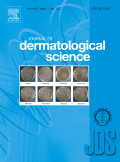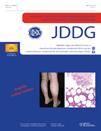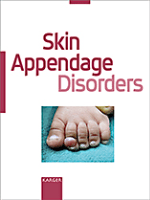
JOURNAL OF DERMATOLOGICAL SCIENCE
Scope & Guideline
Elevating Standards in Dermatological Science
Introduction
Aims and Scopes
- Skin Biology and Pathophysiology:
The journal emphasizes research on the fundamental biology of skin cells, including keratinocytes, melanocytes, and fibroblasts, as well as the pathophysiology of skin diseases such as psoriasis, atopic dermatitis, and skin cancers. - Therapeutic Approaches and Innovations:
There is a significant focus on novel therapeutic strategies, including gene therapy, biologics, and small molecules, aimed at treating skin disorders and enhancing skin health. - Immunological and Inflammatory Mechanisms:
Research exploring the immune responses and inflammatory processes involved in various dermatological conditions is a core area of interest, particularly studies examining cytokine signaling and immune cell interactions. - Regenerative and Reconstructive Dermatology:
The journal covers advancements in regenerative medicine, including stem cell therapies and tissue engineering, as well as studies on wound healing and scar formation. - Epidemiology and Quality of Life:
Research addressing the epidemiological aspects of skin diseases and their impact on patients' quality of life is also a significant aspect of the journal's scope.
Trending and Emerging
- Molecular and Genetic Research:
There is a growing trend towards understanding the molecular and genetic underpinnings of skin diseases, including studies on gene expression, epigenetics, and the role of microRNAs in skin pathologies. - Innovative Therapeutic Strategies:
Emerging themes include the exploration of innovative therapeutic strategies such as gene editing (e.g., CRISPR-Cas9), antibody therapies, and the use of exosomes in treatment approaches. - Microbiome and Skin Health:
Research on the skin microbiome and its relationship to skin health and disease is gaining traction, highlighting the importance of microbial interactions in dermatological conditions. - Translational and Clinical Research:
An increasing number of studies are focused on translating basic scientific findings into clinical applications, showcasing the journal's commitment to bridging the gap between research and practice. - Environmental and Lifestyle Factors:
There is an emerging interest in how environmental factors, such as pollution and UV exposure, and lifestyle choices impact skin health and disease progression.
Declining or Waning
- Traditional Topical Treatments:
There has been a noticeable decline in studies focusing solely on traditional topical treatments for skin conditions, as the field shifts towards more innovative systemic therapies and biologic agents. - Basic Descriptive Studies:
Basic descriptive studies that do not employ advanced methodologies or experimental models have become less common, as the emphasis moves towards studies that provide mechanistic insights or clinical applications. - Non-dermatological Comorbidities:
Research on non-dermatological comorbidities associated with skin diseases has seen less prominence, indicating a potential shift in focus towards more directly relevant dermatological research.
Similar Journals

Dermatologie
Elevating Dermatological Research and PracticeDermatologie, published by SPRINGER HEIDELBERG, is a prominent journal dedicated to the advancing field of dermatology. With its ISSN 2731-7005 and E-ISSN 2731-7013, this journal has established itself as a valuable resource for researchers, professionals, and students alike. Originating in Germany, the journal focuses on disseminating innovative research from 2022 to 2024, contributing significantly to the understanding of skin health and disease management. Despite its current ranking within the Q3 category in dermatology and a Scopus rank of #88/142, it provides critical insights and advances in clinical practice, epidemiology, and therapeutic modalities. With an emphasis on open discourse, it seeks to foster collaboration among healthcare professionals and researchers, thereby enhancing the quality and accessibility of dermatological research. Engage with Dermatologie to stay at the forefront of the latest advancements in skin-related health issues.

INTERNATIONAL JOURNAL OF DERMATOLOGY
Championing excellence in dermatology research.The INTERNATIONAL JOURNAL OF DERMATOLOGY, published by WILEY, stands as a premier scholarly platform in the field of dermatology, with a notable impact factor that affirms its quality and renown. Established in 1963 and converging through to 2024, this journal is recognized as a Q1 category publication, ranking in the top 20% of journals within the dermatology field according to the Scopus ranking system, where it occupies the 28th position among 142 journals. This reflects its dedication to advancing the understanding and treatment of skin diseases, making it a vital resource for researchers, healthcare professionals, and medical students alike. Although it does not provide open access options, articles published in this journal cover a broad range of dermatological topics, ensuring that it serves as a comprehensive and authoritative source for cutting-edge research and clinical practices. With its rigorous peer-review process and commitment to high standards, the INTERNATIONAL JOURNAL OF DERMATOLOGY remains indispensable for those engaged in dermatological science and practice.

JOURNAL DER DEUTSCHEN DERMATOLOGISCHEN GESELLSCHAFT
Advancing dermatological science through rigorous research.JOURNAL DER DEUTSCHEN DERMATOLOGISCHEN GESELLSCHAFT, published by Wiley, is a prominent periodical in the field of dermatology, recognized by its Q2 quartile ranking in the 2023 dermatology category. With a dedicated focus on advancing knowledge in dermatological science, the journal publishes rigorous peer-reviewed research that encompasses a range of topics including clinical studies, research methodologies, and innovative treatment practices in dermatology. Its impact is reflected in its Scopus ranking, where it stands at #48 out of 142 in the medicine dermatology category, placing it in the top 66th percentile. Although not an Open Access journal, it serves as a critical resource for researchers, clinicians, and students alike, facilitating the dissemination of high-quality research findings and fostering a deeper understanding of dermatological conditions and treatments. With years of convergence from 2003 to 2024, this journal remains a vital platform for scholarly dialogue and discovery in dermatology.

Skin Appendage Disorders
Exploring the Frontiers of Dermatological ScienceSkin Appendage Disorders, published by KARGER, is an esteemed academic journal focusing on the intricate realm of dermatology, particularly the structure and function of skin appendages. Established in 2016 and projected to continue through 2024, this journal has swiftly gained recognition, securing a respectable Q2 ranking in the field of Dermatology as of 2023, and achieving a Scopus rank of 76 out of 142 in the same category. With an ISSN of 2296-9195 and an E-ISSN of 2296-9160, the journal presents a platform for innovative research and clinical findings that address the multifaceted aspects of skin appendage disorders. Researchers, practitioners, and students will find significant value in its open access model, which encourages widespread dissemination of knowledge and fosters collaboration within the dermatological community. By publishing high-quality peer-reviewed articles, Skin Appendage Disorders aims to elevate the understanding of dermatological conditions and contribute to advancements in therapeutic practices, making it a vital resource for those dedicated to skin health.

SKIN RESEARCH AND TECHNOLOGY
Transforming Skin Research with Cutting-Edge Technologies.SKIN RESEARCH AND TECHNOLOGY, a distinguished publication by Wiley, stands at the forefront of dermatological science, emphasizing innovative research and technological advances in skin health. With an ISSN of 0909-752X and an E-ISSN of 1600-0846, this journal serves as a vital platform for researchers and professionals to present their findings and engage in discussions surrounding skin biology, clinical practices, and therapeutic technologies. As evidenced by its respectable Q2 ranking in the dermatology category for 2023 and a Q3 status in miscellaneous medicine, the journal attracts a broad readership and contributes significantly to the field. Housed in the United Kingdom with publications spanning from 1995 to 2024, SKIN RESEARCH AND TECHNOLOGY continues to foster innovation and knowledge dissemination in skin-related research. While its Access options are not open, the impact of the journal remains prominent, appealing to academic professionals and students eager to explore emerging trends and advancements in dermatological studies.

INDIAN JOURNAL OF DERMATOLOGY
Pioneering insights into skin health and disease.INDIAN JOURNAL OF DERMATOLOGY, published by Wolters Kluwer Medknow Publications, is a renowned open-access journal that has been a significant platform for disseminating vital research in the field of dermatology since its inception in 1962. With an ISSN of 0019-5154 and an E-ISSN of 1998-3611, the journal covers a comprehensive array of topics relevant to skin health and diseases, serving both academic and clinical audiences in India and beyond. Having transitioned to an open access model in 2005, it strives to enhance the reach and impact of dermatological research. The journal is classified in the Q3 quartile within the dermatology category as of 2023 and ranks 82 out of 142 in Scopus, showcasing its contribution to the field despite competitive rankings. By fostering scholarly communication and providing a rigorous peer-review process, the INDIAN JOURNAL OF DERMATOLOGY remains a vital resource for researchers, practitioners, and students devoted to advancing the understanding and treatment of skin disorders.

Journal of Cutaneous Immunology and Allergy
Exploring the frontiers of dermatological and immunological research.The Journal of Cutaneous Immunology and Allergy, published by FRONTIERS MEDIA SA in Switzerland, is an esteemed Open Access platform dedicated to advancing research in the intersecting fields of dermatology, immunology, and allergy. Since its inception in 2018, this journal has provided a vital resource for the dissemination of innovative research findings and critical reviews, enhancing our understanding of cutaneous conditions related to immune responses. Although currently classified in the Q4 quartile in both Dermatology and Immunology & Allergy categories as of 2023, the journal continues to strive for recognition within the scientific community, encouraging collaboration and knowledge sharing among researchers, clinicians, and experts. The journal boasts an E-ISSN of 2574-4593 and is committed to making high-quality research freely accessible to all, thus fostering greater insights into the complexities of skin-related immune disorders. Join us in this journey to explore the forefront of cutaneous research and contribute to the evolving dialogue in this dynamic field.

AUSTRALASIAN JOURNAL OF DERMATOLOGY
Pioneering insights in dermatological advancements.Australasian Journal of Dermatology is a leading publication in the field of dermatology, issued by Wiley since 1951, and reaching an audience of researchers, clinicians, and students interested in the latest advancements and practices in skin health. With an ISSN of 0004-8380 and an E-ISSN of 1440-0960, this journal stands out with its Q2 ranking in both Dermatology and Miscellaneous Medicine, positioning it within the top 61st percentile of its category according to Scopus. Although it does not provide Open Access options, Australasian Journal of Dermatology is committed to disseminating high-quality research that informs clinical practices and promotes scholarly dialogue. By publishing rigorous and peer-reviewed articles focused on various aspects of dermatological science, the journal plays a pivotal role in enhancing the dermatology community's understanding of skin conditions and treatments, making it an invaluable resource for professionals and students alike.

ANAIS BRASILEIROS DE DERMATOLOGIA
Bridging Local Expertise with Global Dermatological Trends.ANAIS BRASILEIROS DE DERMATOLOGIA is a prestigious academic journal published by Elsevier Science Inc, specializing in the dynamic field of dermatology. With its Open Access model established in 2002, this journal ensures wide dissemination of research findings and facilitates collaboration within the dermatological community. Hailing from Brazil, it provides a platform for innovative research from both local and international contributors, spanning from its inception in 1963 to the current year, 2024. The journal positions itself as a vital resource in the dermatology sphere, currently ranked in the Q3 category for dermatology and holding a notable rank of 71 out of 142 in the Scopus rankings, placing it in the 50th percentile for its field. With a commitment to advancing knowledge and practice in dermatology, ANAIS BRASILEIROS DE DERMATOLOGIA is an essential read for researchers, professionals, and students eager to explore contemporary advancements and clinical practices.

Dermatology Practical & Conceptual
Exploring innovative solutions in skin health and research.Dermatology Practical & Conceptual is a prominent open-access journal dedicated to advancing the field of dermatology through the dissemination of cutting-edge research and practical insights. Published by MATTIOLI 1885, this peer-reviewed journal has been committed to open access since 2015, ensuring that valuable information is readily available to researchers, healthcare professionals, and students worldwide. With a focus on innovative and practical approaches in dermatology, as well as its intersections with genetics, molecular biology, and oncology, the journal has established a strong academic presence, achieving a Q2 ranking in Dermatology and notable positions in related fields for 2023. Although its Scopus rankings indicate room for improvement in certain areas, such as genetics and molecular biology, the journal's commitment to quality and accessibility is evident in its engagement with contemporary research trends. The editors invite submissions that address practical challenges and novel methodologies, fostering a multidisciplinary dialogue that enhances dermatological practice and research. The journal operates from its base in Fidenza, Italy, and as it looks toward converged years from 2019 to 2024, it aims to further strengthen its influence and contribute significantly to the dermatological landscape.